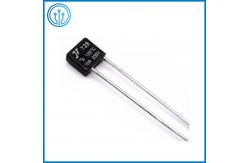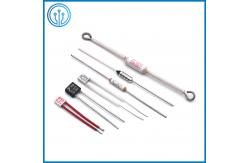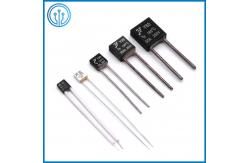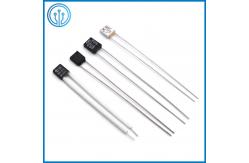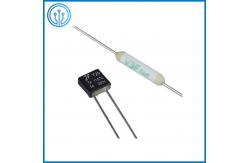102C 115C 125C 130C 150C Square RH Thermal Fuse 10A 250V
|
|
Y Series Square RH Thermal Fuse Thermal Cutoff Limiter 102C 115C 125C 130C 150C 10A 250V For Electric Faucet
1 Product description Of The RH Thermal Fuse Thermal Cutoff Limiter 10A 250V
The purpose of a Thermal fuse is typically to be a cutoff for heat producing devices. As the name implies, thermal fuses are usually found in heat-producing electrical appliances such as coffee makers and hair dryers. They function as safety devices to disconnect the current to the heating element in case of a malfunction (such as a defective thermostat) that would otherwise allow the temperature to rise to dangerous levels, possibly starting a fire.
2 Working principle Of The RH Thermal Fuse Thermal Cutoff Limiter 10A 250V
When the temperature of the equipment rises abnormally, the thermal fuse is induced to heat, and when the temperature reaches the set temperature of the alloy, the low melting point is melted, and the surface tension of the molten alloy increases under the action of the special resin, causing the alloy to shrink in a spherical shape. On the lead wire, the circuit is completely cut off.
3 Anatomy Diagram Of The RH Thermal Fuse Thermal Cutoff Limiter 10A 250V
4 Product installation guidelines Of The RH Thermal Fuse Thermal Cutoff Limiter 10A 250V
* Keep a distance of 3mm from the fuse body when bending the wire. * When welding or soldering exceeds the rated temperature of the fuse, the longer the welding distance and the shorter the welding time, the less damage to the fuse. * Be careful of the current flowing in the insurance body. * Do not use liquids or toxic gases such as sulfuric acid and nitric oxide. * Do not connect the heater and the fuse directly.
5 Dimension Of The RH Thermal Fuse Thermal Cutoff Limiter 10A 250V (mm)
6 Electrical Performances Of The RH Thermal Fuse Thermal Cutoff Limiter 10A 250V
7 Company Introduction Of The RH Thermal Fuse Thermal Cutoff Limiter 10A 250V
* Our company is located in Shilong Town, Dongguan City, Guangdong
Province. It is a high-tech enterprise specializing in the
production of thermal fuses.
8 Quality Assurance Of The RH Thermal Fuse Thermal Cutoff Limiter 10A 250V
9 More Products Of The RH Thermal Fuse Thermal Cutoff Limiter 10A 250V
10 Some Frequently Asked Questions about The RH Thermal Fuse Thermal Cutoff Limiter 10A 250V
1. How is a thermal fuse different from an electric fuse? An electric fuse is a common name of a thermal fuse. The thermal fuse is of two types. The one which melts at a certain high temperature The one which disconnects due to sub-zero temperature as required. Hypo thermal fuse is made of Biometal but a simple electric thermal fuse can be of any metal or alloy. There is another fuse that does not blow but disconnects the electric circuit. This is called a magnetic fuse. This used in circuit breaker. 2. Are thermal fuses universal? If by “universal” you mean “one size fits all”, then no. Thermal fuses come in a range of temperatures. The only ones I’ve bought are to replace failed ones in coffee makers, and I picked ones rated at around 110*C with an appropriate current capacity. Did not search for anything else, but higher current capacity units must exist. For those who have not run into these devices, they operate like any other fuse in that they are installed in series with the power source, but are designed to be relatively insensitive to current and to open when their temperature exceeds the design point. A valuable safety device in heated appliances. 3. How do I test a dryer thermal fuse? First of all, understand that once a certain amount of current goes through any kind of fuse, the fuse blows and can only be replaced, not repaired. So then, the only test you really want to do is to see if the fuse can still conduct electricity. Unplug the power cable and disconnect either end of the thermal fuse. Connect any cheap ohm meter to the loose end and the other end. If you get a reading, you may consider the fuse to be good. Don’t have a meter? In that case, you can use an old flashlight bulb (not LED), along with a battery and a piece of wire to test the fuse. Press the base of the bulb against one node of the battery while pressing the opposite end of the battery to one of the 2 fuse connections. At the same time, hold a test wire between the side of the bulb and the other fuse wire. If the fuse is good, the light will turn on. 4. How do I know if my thermal fuse is blown? Using a digital or analog multimeter, or other resistance-measuring instruments, check the resistance across the thermal fuse (preferably when it’s out of the circuit, which can affect the reading), If you read continuity (in the range of several ohms or less, depending on its rating), the fuse is still functional. If you read an open circuit, the fuse is blown, and has to be replaced. 5. How do you test a fuse using a multimeter? Testing connectivity is the best way of testing a fuse. A fuse works as long as its two terminals are connected by wire i.e. the two terminals of the fuse are shorted. If the connectivity test fails then it is sure that the fuse isn’t working. However, there might arise a case if the fuse isn’t using proper material. There might not be any connectivity, however, testing the resistance between the two terminals would give a small non-zero value. Even in such cases, we say that the fuse is working. However, such cases rarely exist and if they do we don’t consider as a good fuse (at least for the small power applications like a household) 6. What is the function of the thermal fuse of an electric fan? When the oil in the cheap sleeve bearings in the cheap shaded pole motor gets gummy, the motor will start drawing more current and run hotter. If the motor is not re-lubricated in a timely manner, eventually the sleeve bearings will get stuck and the rotor will fail to turn. This results in a locked-rotor condition and the windings draw more current and produce more heat than they can dissipate with no airflow over them to provide cooling. Eventually, the enamel insulation degrades and gets hot enough to smoke, possibly producing shorted turns that draw even more current. The thermal fuse is a safety device to prevent the cheap motor from actually catching on fire. Sometimes the fuse can be replaced and the bearings can be relubricated to get another year or two of service if the windings haven’t discolored from overheating, but you can be sure that the end is near. You are better off getting a fan motor with sealed ball bearings. They cost more but last much longer, and usually give you a warning by making a rattling noise when the bearings start to wear out rather than seizing silently. 7. What material is used for making electrical fuses and why? Electrical fuses are generally made from materials having low melting. It acts as a low resistance path when the current flowing through it exceeds its rating by even a small amount. This is done to protect an electrical device from getting damaged. Thus, it acts as an overcurrent protection device. During faults, especially short circuit faults, when heavy currents suddenly flow, the fuse wire gets heated up and melts down, thereby preventing damage and fires from occurring. The fuse wires in general are made of nichrome, etc.
|
|||||||||||||||||||||||||||||||||||||||||||||||||||||||||||||||||||
| Product Tags: Square RH Thermal Fuse 150C RH Thermal Fuse 10A 250V Thermal Cutoff Fuse | |||||||||||||||||||||||||||||||||||||||||||||||||||||||||||||||||||
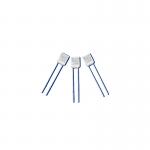
|
Plastic Square Shell TT 5A 250V 300V Defrost Thermal Fuse 76-150C For Steam Iron Hair Dryer Kettle Refrigerator |
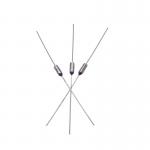
|
Therm - O - Disc Temperature Fuse G7F51184C 5A 250V Tf 184C Th 169C For Automotive Electromagnetic Clutch Motor |

|
Microtemp Thermal Cut Off Fuse G6A01084C 16A 250V 84C For Soymilk Machine Water Heater |

|
Microtemp G5A01134C Oven Thermal Fuse Link 20A 250V 134C For Capsule Coffee Machine |
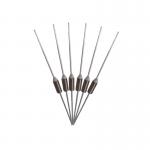
|
Microtemp Dryer Thermal Fuse G4A01257C 10A 250V 257C Cutoff Switch For Automatic Dripping Coffee Pot |
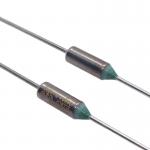
|
Metal Case BF Pellet TCO Non-Resettable Fuse Link G4A01167C 10A 250V 167C For Temperature Protection Of Electric Cookers |

